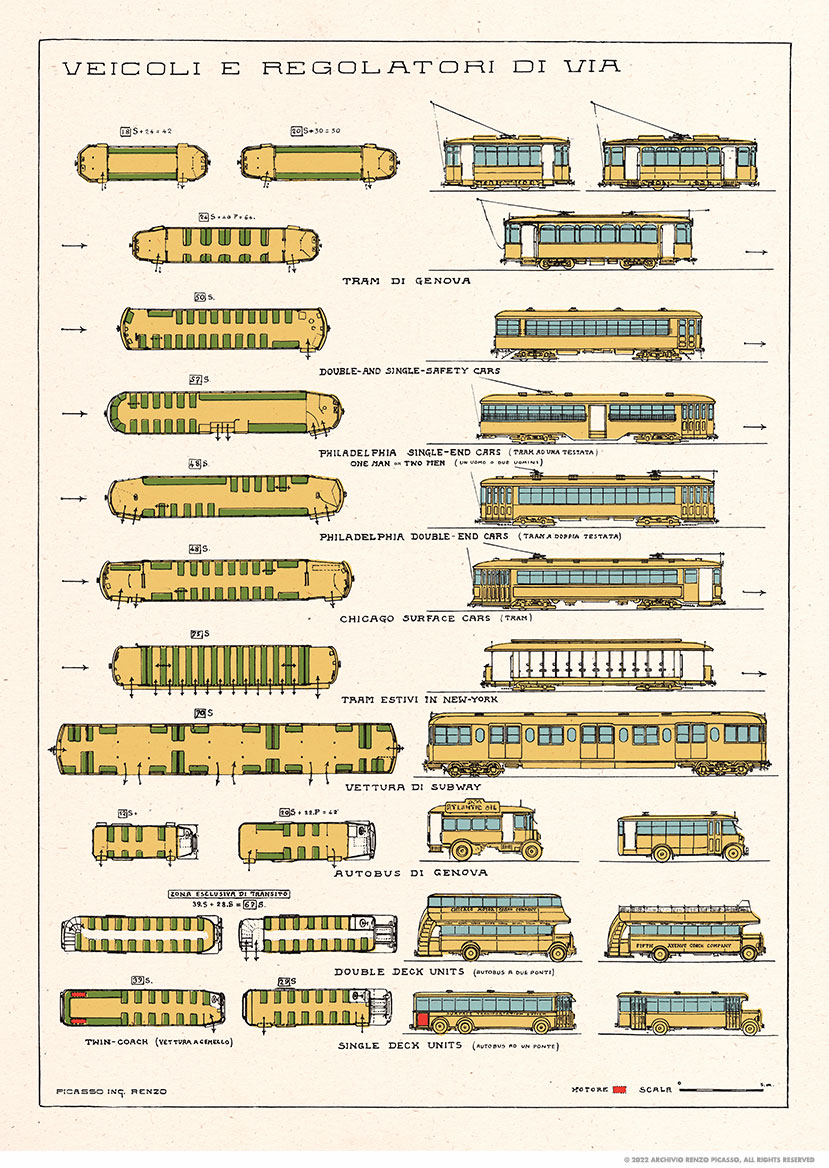


Included are the car interiors as well, with the seats labeled in green while the capacity is displayed above (S refers to seduta, Italian for seat, while P stands for in piedi, referring to passengers standing) Picasso lines these up in descending order by type of vehicle, so that viewers are able to compare the differences between the those of his native Genoa with those of the same type from America. In this case, the Genoese transportation is generally smaller and more restrictive than its American counterparts, forcing most passengers to stand to even attempt to reach comparative numbers to American capacity. In addition, this plan was originally part of a three page set, titled “VEICOLI E REGOLATORI DI VIA,” alongside the intersections page and the traffic lights page. As the set is labeled “Vehicles and Regulators of the Road,” the overall plan demonstrates the unison of the various technologies of transportation so that readers in his home city of Genoa who did not have access to these American innovations could obtain a thorough understanding of how these things overlap.
ON A CURIOUS NOTE:
One interesting quirk of the Genoese buses would be their rather elevated step into the vehicle. On another one of Picasso's drawings, he depicts the need for men to help lift a woman into the bus due to the step being too high for her on her own. In addition, the leftmost American single deck bus is the only one with its engine location labeled. This is because due to the lack of a nose on the vehicle, the engine was moved to the back of the bus to prevent interfering with the driver or passengers.
Questo disegno, realizzato dall'architetto italiano Renzo Picasso, mostra diversi veicoli utilizzati come trasporto pubblico in una varietà di città come Genova, l'isola di Manhattan di New York, Filadelfia e Chicago.
Sono inclusi anche gli interni dell'auto, con i sedili etichettati in verde mentre la capacità è visualizzata sopra (S si riferisce a seduta, italiano per sedile, mentre P sta per in piedi, riferendosi ai passeggeri in piedi) Picasso li allinea in ordine decrescente per tipo di veicolo, in modo che i telespettatori possano confrontare le differenze tra quelli della natia Genova e quelli dello stesso tipo provenienti dall'America. In questo caso, il trasporto genovese è generalmente più piccolo e più restrittivo delle sue controparti americane, costringendo la maggior parte dei passeggeri a resistere anche solo a tentare di raggiungere numeri comparativi alla capacità americana. Inoltre, questo piano faceva originariamente parte di un insieme di tre pagine, intitolato “VEICOLI E REGOLATORI DI VIA”, accanto alla pagina degli incroci e alla pagina dei semafori.
Poiché il set è etichettato come “VEICOLI E REGOLATORI DI VIA”, il piano generale dimostra l'unisono delle varie tecnologie di trasporto in modo che i lettori nella sua città natale di Genova che non hanno avuto accesso a queste innovazioni americane potessero ottenere una comprensione approfondita di come queste cose si sovrappongono.
NOTA CURIOSA:
Una stranezza interessante degli autobus genovesi sarebbe il loro gradino piuttosto elevato nel veicolo. In un altro dei disegni di Picasso, descrive la necessità che gli uomini aiutino a sollevare una donna sull'autobus a causa del gradino troppo alto per lei da sola. Inoltre, l'autobus a un piano americano più a sinistra è l'unico con la posizione del motore etichettata. Questo perché a causa della mancanza di un muso sul veicolo, il motore è stato spostato nella parte posteriore dell'autobus per evitare di interferire con l'autista o i passeggeri.